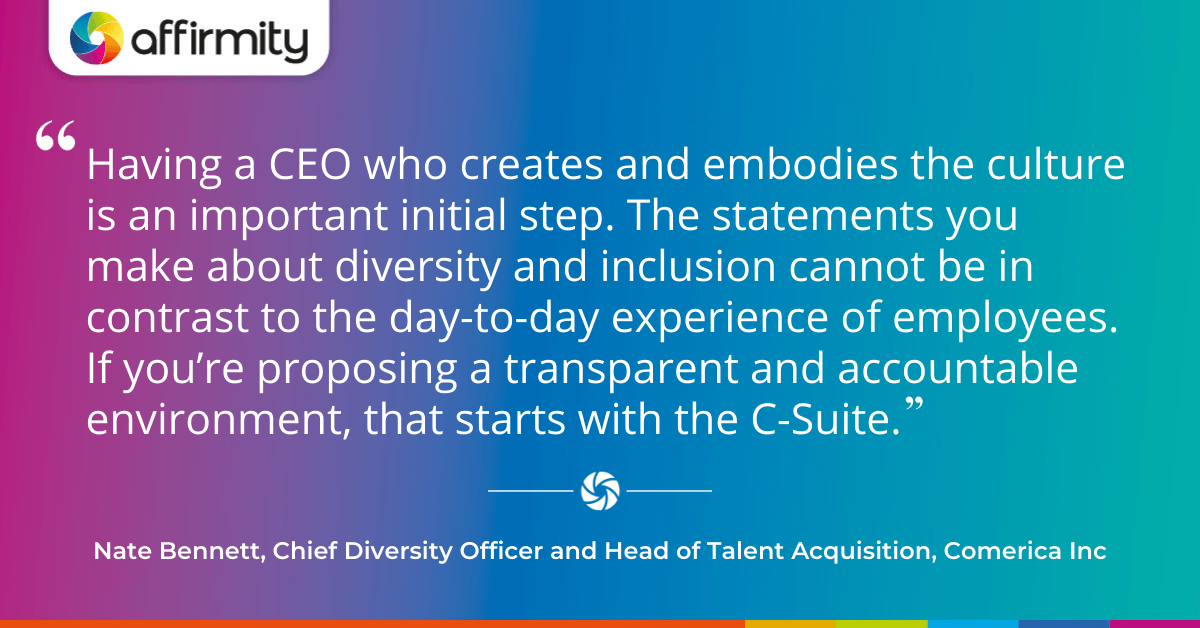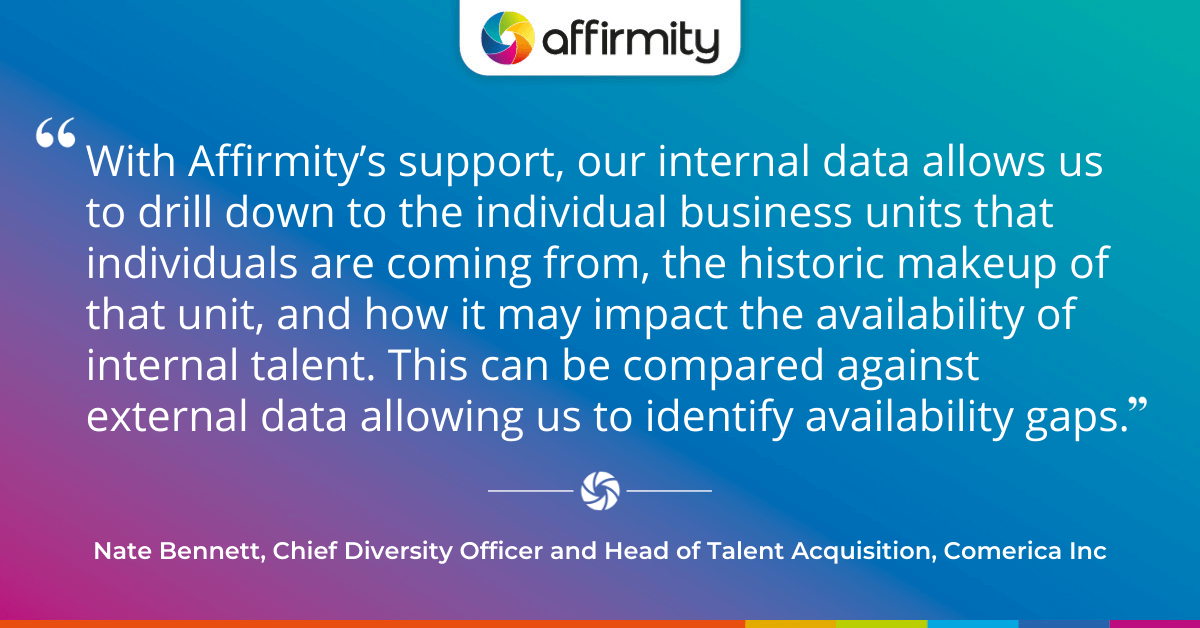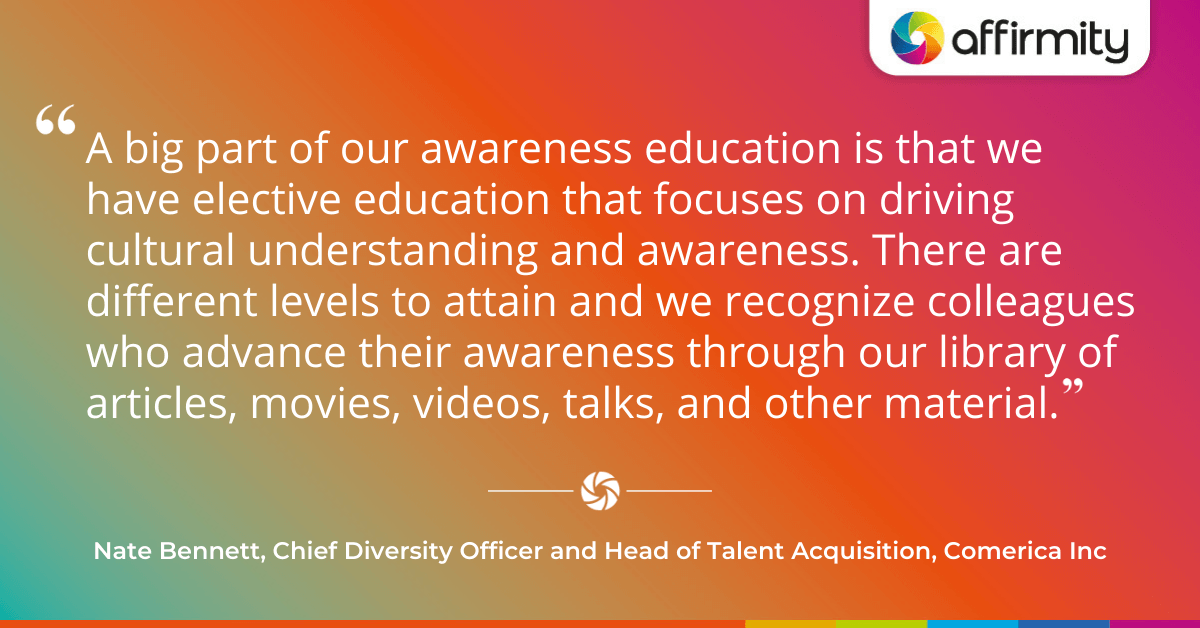A successful DE&I strategy starts with a C-Suite that embodies the culture it wants to create. In this Q&A session, Comerica’s Chief Diversity Officer reveals how the organization has cultivated and monitored real cultural change with assistance from Affirmity’s experts.
We recently sat down with Nate Bennett, Chief Diversity Officer and Head of Talent Acquisition at financial services company Comerica Inc. to discuss DE&I strategy. We asked Nate about Comerica’s approach to the key leadership, data, and cultural questions currently facing organizations around the world.
Leadership: Transparency, Accountability, and Balance

Question: What are some ways in which leadership can integrate transparency and accountability?
Nate: Having a CEO who creates and embodies the culture is an important initial step to seeing that culture reflected across the organization in colleagues, managers, and leaders. The statements you make about diversity and inclusion cannot be in stark contrast to the day-to-day experience of your employees. If you’re proposing a transparent and accountable environment, that starts with the C-Suite.
To be successful, your C-Suite also needs targets, and a clear idea of what they want to achieve, and the overall business strategy and impact they intend to receive. They must then consider how they intend to measure progress against those goals. At Comerica, we use a diversity scorecard with various different categories and the short-term and long-term goals our leaders are measured against.
These targets help our leadership easily understand what they’re accountable for, and hints at the path to integrating those goals into the foundational business strategy. Having a partner—in our case, Affirmity—that can assist with the measurement of these targets, and the knowledge to help us act on the insight that data gives us is invaluable.
Lastly, leadership needs employee engagement processes that allow them to listen to feedback from colleagues, responding, addressing, mitigating, and actualizing as appropriate.
More from the blog: ‘5 Ways to Prepare for Your 2021 Affirmative Action and Diversity Initiatives’
Question: How can company leaders ensure a balance in their leadership ranks?
Nate: You really have to walk the talk. When our CEO took over the role a little over a year ago, he had an opportunity to revamp his C-Suite. Today 50% of our C-Suite are women and roughly 20% are minorities. So we’re already where we want to be with our gender balance, but our balance of minorities is still a work in progress.
Then there’s a workforce diversity component to the strategy—so asking what’s your organization-wide representation, and how does that impact overall strategy? Comerica sets targets not only at C-Suite level, but at all levels of the organization, and these targets are informed by internal and external availability. In turn, we’ve had to balance our talent and succession management processes—enforced by goals and action plans in our diversity scorecard—so that top-to-bottom we can move towards a better balance of representation.
Company leaders also have to focus on regularly driving the right behaviors among those in a leadership role. Our manager essentials program covers leadership competencies such as inclusion management that are critical for each specific leadership role.
Finally, it’s important to drive home how diversity and inclusion positively impacts each line of business, and the potential negative effects when they are absent. We’ve spent a lot of time showing our leaders these potential impacts, with the view of having individuals in leadership roles who understand why this is partly their responsibility and why it’s important.
Metrics: Monitoring Quantity and Quality

Question: Does Comerica focus on metrics that quantify diverse talent representation as well as the quality of engagement inclusiveness, and what are some of the key metrics that are your primary focus?
Nate: An organization’s ability to assess, engage and understand where their workforce is currently and where it needs to go—identifying any inequities that exist and how they can be addressed—is obviously a critical element of DE&I strategy. You will inevitably need to invest in and develop a skillset in your organization, or to work with a partner who can help you through that process.
Our diversity scorecard has several different categories covering both quantitative and qualitative aspects:
- On the quantitative side, we look at representation by level, and line of business. We create short-term and long-term goals based on workforce utilization and availability.
- This is achieved by measuring what our workforce looks like internally, and then what is the availability of the workforce for each particular component or line of business—whether that be technology, commercial bank, within corporate staff, or another area.
- With Affirmity’s support, our internal data allows us to drill down to the individual business units that individuals are coming from, what the historic makeup of that unit is, and how it may impact the availability of talent internally. This can be compared against external availability and allows us to identify availability gaps.
- On the qualitative side, we have a series of regular questionnaires internally branded ‘the voice of the colleague’. This gives us sentiment data and allows us to recognize when certain groups are experiencing inequities.
Also on the blog: ‘How to Use a Climate Survey to Understand and Nurture Diversity and Inclusion’
Question: How does Comerica regularly monitor representation against internal and external data?
Nate: In this line of work, you can be inundated with data, so we usually narrow our sources down to a select few and consider how to best utilize them in terms of developing our own internal strategy. Externally speaking, we participate in and measure ourselves against the DiversityInc survey (we rank third on the list of top regional companies), HACR (Hispanic Association for Corporate Responsibility), and the Corporate Equality Index.
It’s important to be broad and vast in terms of your thinking, but it can be an information overload. The main thing is to ask “what are the select few partners that are going to give us the best and most relevant data for our organization?
Dialogue: Equity, Authenticity, and Language

Question: What are some ways organizations can incorporate equity?
Nate: We do a full-scale compensation analysis on an annual basis. Working with HR and our total rewards leader, we also consider equitable benefits, and look at policies and practices that potentially drive inequities. A pressing example right now is around the return to office. Organizations will have to have robust, equitable strategies around when employees can return and the degree of flexibility around where they may work. And this all has to be done without disadvantaging or endangering any one group.
It can also be important to establish and leverage employee resource groups (ERGs). These groups help us manage the equity versus equality conversation and install mitigation efforts via professional development and mentoring programs (and beyond).
Equity can be perceived by the majority as being unfair and unbalanced, so we have to be very mindful and cautious about how that majority is included in mitigating efforts. We help them understand that this is a measure for us to create a level playing field that will ultimately help everyone in the organization.
More on ERGs: ‘5 Key Steps in the Creation, Growth and Evolution of Your ERGs’.
Question: What can companies do—in terms of training, or program implementation—to promote authentic conversations and dialogue, and what is the potential impact?
Nate: We actually try to stay away from the word “training” and label everything as “educational experiences”. We shaped our D&I educational platform around three critical areas: Awareness, Anti-Racism, and Inclusion.
- Awareness: Through various vehicles, we educate our colleagues to ensure they’re aware of and understand the different cultures and different diversity dimensions in our organization.
- Anti-racism: We are committed to helping individuals understand how individuals view and are viewed by others. Not specific to biological or genetic makeup, but the socio-economic impact—the things that have made them—which creates their perceptions.
- Inclusion: Is really about where we want to lead our colleagues and we’re in the process of reshaping it.
Your CEO must set the culture, and be part of the freeing of the organization to have those conversations. If the environment doesn’t exist at leadership level, it’s going to make it very difficult for colleagues to share their stories and how they’re feeling. And stories are really what we use in our education and dialog.
There are a lot of different dimensions to cover in our discussions: from motherhood and protecting children, to conversations about LGBTQ rights. We hold large webinar sessions, and we also engage in a lot of activity around our awareness work. For example, we have the ‘Comerica celebrates diversity’ program which is our way of recognizing the different heritage months.
Question: What are some ways in which your organization encourages additional learning about other cultures and promoting inclusion?
Nate: We’re fortunate in that we’re fairly mature in our process but we’re always looking to do more. I spend a lot of time sitting on advisory groups, asking my peers what they’re doing, and seeing how that might have an impact on our organization.
A big part of our awareness education is that we have elective education—a ‘Masters of Diversity’ program—that focuses on driving cultural understanding and awareness. There are different levels to attain and we recognize colleagues who advance their awareness through our library of articles, movies, videos, TED talks, and other material.
We have external partners that provide continuing education, mainly to ERG chairs and leadership teams, but also to the wider colleague community. The diversity section on our intranet includes a calendar of events, as well as recordings of previous internal and external events. We also provide access to external resource libraries, such as those of DiversityInc. and our other partners.
Finally, we have ‘inclusion councils’ made up of colleagues from across the organization who want to contribute to our D&I focus but don’t necessarily fall into a specific affinity. They are currently leading a series right now on allyship, covering how to be an ally from various perspectives.
